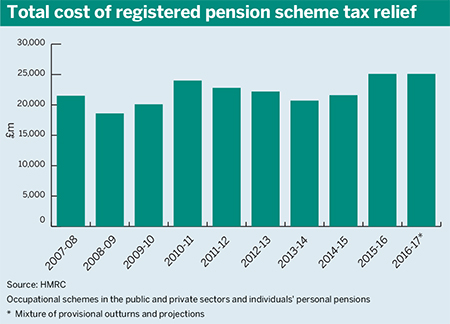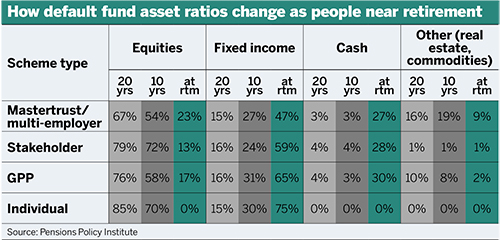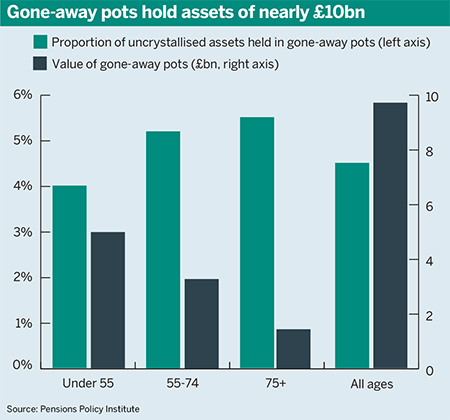After many years of tinkering, a lot of people in the pensions industry pray for no news and stability in the Department for Work and Pensions' policy announcements. But what changes could benefit savers, rather than the taxman? Five defined contribution experts discuss.

The Autumn Budget left pensions taxation alone despite perennial worries from the industry. Is the current system fair, or should a flat rate of tax relief be introduced?
Darren Philp: The current system is in dire need of reform. It is heinously complicated and suffers from a number of well-documented injustices.
It has become something of a political plaything over time, with constant tinkering and slashing of allowances. It is a system that is skewed away from auto-enrolment savers and does very little to incentivise people to save, other than for those with higher incomes.
My view is that the government needs to pivot and provide a long-lasting reform of the system that strikes away complexity, supports auto-enrolment and is sustainable into the future.
Although change will not be easy, and there will be many naysayers, a move to a flat rate of tax relief or a government top-up should be considered so relief really supports long-term saving.
It is also nonsense that lower-income savers cannot get the tax relief they deserve just because they happen to be in a pension scheme running a net-pay arrangement.
This problem pre-dates auto-enrolment and is a problem of the government’s own making. It has the power to fix it, and the recent Budget was very much a missed opportunity to sort this mess out.
Above all, we need a system that treats all savers fairly, that avoids different tax incentives for those saving in different types of pensions, and does not exacerbate intergenerational unfairness.
Naomi L’Estrange: The current system is not really fair and puts the incentives to save in precisely the wrong place.
But as we have all learned to our cost, adding ‘simple’ solutions to a complex system just tends to make things worse.
Given that any changes in the Autumn Budget were more likely to be motivated by short-term tax receipts than long-term savings outcomes, I was in the camp of being relieved at no change this time.
Natanje Holt: The issue around tax relief is not about fairness, it is about the cost to government. There is a perceived ‘unfairness’ across the entire pension system.
There are large discrepancies between defined benefit and defined contribution, benefiting DB pensioners. Within DB pension schemes arguably there is unfairness around the protection and benefits different members receive.
The concept of the lifetime allowance punishing people for good returns is arguably not fair. The abolition of contracting out, without an additional tax on protected rights in personal pensions was not fair.
Increasing the state pension age for women at the pace set out has been deemed unfair by many. The differences between net-pay schemes and relief-at-source arrangements can also be included on the list.
The government’s balancing act between the power of the public sector, the need to raise tax, support savings and not give away too much money arguably results in decisions that would benefit some and penalise others.

Olivia Davis: Pension taxation is very complex and not well (or at all) understood by most members. There is scope to change the presentation of pension tax relief to improve understanding and increase its role in incentivising saving.
For example, tax relief could be presented as a matching contribution (eg £1 from the government for every £3 saved), which should be clearer and easier to understand.
We need also to look hard at the complexity created by the annual and lifetime allowances and the associated tapers. These create confusion for members and complexity for employers.
Flat rate relief may have some benefits in terms of simplicity of concept and potentially more even distribution of the benefit across the population, but we need to be wary of complexity in the implementation.
Mark Jaffray: Given the lack of news coming from the Treasury in advance of the Budget I was not completely surprised by tax relief’s absence.
There is clearly an inequity as high earners receive a larger share of the c£35bn tax relief the government spends each year.
This is partly down to the fact they have higher salaries and higher contributions and, crucially, are taxed at a higher rate. A single flat rate of relief applying to every individual would be fairer.
A current issue, and perhaps one that needs addressing more urgently, is the inequity between tax relief received by non-taxpayers in schemes. This could impact around 1m of the UK’s lowest earners.
Non-taxpayers who are in schemes operating a relief-at-source arrangement (and do get tax relief on their contributions) are essentially 20 per cent better off pension-wise, compared with similar individuals in a net-pay arrangement (who do not receive tax relief).
Should the charge cap on DC defaults be amended to facilitate greater investment in patient capital?
L’Estrange: I am torn here. The charge cap is a blunt instrument, which drives managers towards passive strategies and discourages innovation in areas like patient capital and environmental, social and governance-based investing.
But on the other hand, charges across DC were simply too high, and it has been the biggest driver of improved value for members. If we breach the dam now, every active fund in the market would suddenly meet the criteria and the benefit of the cap could be lost.
I suspect we need a bit more time with the cap where it is, and a bit more traction on the transparency side, so better habits on holding providers to account on charges are embedded. It will then be possible to say whether new patient capital funds justify higher charges (which they quite possibly do).
Jaffray: Some flexibility could be built into the charge cap to allow for charging structures common to patient capital investments, eg around performance fees.
This could work in principle – higher fees are only paid in return for higher returns and better outcomes. That said, 0.75 per cent a year seems a reasonable total annual charge for an individual and I would not be in favour of increasing that per se.
I would want a lot of evidence that any investment (patient capital included) was going to produce expected returns higher than other assets to justify any meaningful relaxation of the current charge cap.

Davis: I do not think this is a good idea. Most large schemes already operate well under the charge cap.
There is already scope for allocations to patient capital and other private markets investments, should trustees decide strategies will improve net-of-fees returns for members.
Allocations to patient capital are unlikely to exceed 10 per cent or 20 per cent on diversification grounds and the charge cap will not be a constraint on that.
Performance fees may create some administrative challenges but can be worked around, or other fee models used. Low-cost index-based exposure to public equity and bond markets will remain the core of DC investment and the key driver of return for members.
Holt: The ability to allow DC funds to invest in illiquid assets for greater growth in the longer term is a good development. As the size of DC funds grows their power will increase.
This will improve their ability to keep costs low and ensure there are appropriate performance fees.
The consultation will support industry debate around the charge cap and the charges paid for patient capital. This in turn should inform the industry and regulators on the most appropriate approach to access illiquids while ensuring good value for members, with good investment opportunities and limited opportunity to abuse any changes on the charge caps.
Philp: It is good that the government is looking at how to open up investment in patient capital for pension funds. But while such a move would be revolutionary for the business world, funds need to tread carefully.
We saw with previous Treasury attempts to open up infrastructure to pension funds, that funds should only invest where it is in their interests to do so.
While opening up alternative asset classes is welcome, trustees and schemes need to ensure they are doing what is right for scheme members and not simply bow to the latest political pressure to invest in a certain way.
While DC pension funds do need to diversify away from the traditional asset classes and incorporate alternatives into their portfolios, they are expensive and not necessarily conducive to the fee pressure in the DC world.
While it is clearly right to look at the consequences of the charge cap, particularly if it is fettering schemes’ access to assets that could really benefit members, we need to ensure that pensions retain value for members and that the positive strides we have made to increase transparency in pension charges are not diluted.
What one piece of pensions policy would you like to see carried forward in 2019?
Philp: Dashboard, dashboard, dashboard. The pensions dashboard is a potential game-changer. A one-stop-shop for people to view all their pensions information in the same place will change the way people manage and think about their retirement.
But there is real frustration here. As an industry we have been talking about a pensions dashboard for far too long, and the time has come to take a leap of faith and get on with delivering it. This infrastructure will open up pensions, give people a sense of ownership of their retirement savings, and put them in control of their data.
Crucially all types of pensions – the state pension included – need to be made to provide data to the dashboard, so we need a commitment from government to legislate.
The tech is proven, there is a strong will to make it happen, so we now need to stop talking about it and get on with delivering it.
Let us hope 2019 is the year that the dashboard moves to the next level.

Davis: As ever, a period of stability and consistency of policy would be welcomed and would help to build confidence in the system.
We are keen to see implementation of the conclusions of the Financial Conduct Authority’s retirement outcomes review. In particular, the introduction of default investment pathways will create a simpler set of retirement income decisions for members accessing their savings.
Clarity on the regime for collective defined contribution and the role it can play in the system will also be helpful.
Holt: I would like to see a financial MOT for all those aged 45 and over, with clear guidance on how to maximise your retirement savings.
Increasing pensions contributions for the remaining working years could make a significant difference to this cohort’s outcomes in retirement. It targets a demographic that sits between the end of the era where a lot of workers had DB pensions, and the more recent auto-enrolment era.
The issues facing this group do not appear in the media very often. However, with few of them likely to benefit from DB pensions or a full working career of auto-enrolment contributions, there could be trouble ahead.
In addition, the majority of this cohort will see their parents retiring relatively comfortably and will have to come to terms with working for longer and reducing their cost of living on a reduced pension.
Proving a good indication of financial health, with some guidance on what could be done to improve the situation, could help people to engage and prepare better – whether that is financially, by planning a longer career path, or a combination of options.
As a national initiative it will certainly raise awareness and it could be a noteworthy experiment to establish how this can increase engagement and interest in the future.
It is in the industry’s interest to participate, and while there will be a cost involved, it should result in increased savings.
It is in the government’s interest as it will raise awareness, possibly reducing some level of future burden on the state and society, not to mention future tax revenue.
Jaffray: If I could support one policy goal on my ‘pensions wishlist’ it would be changes that would improve outcomes for the population more generally.
In my view, this would include extending the auto-enrolment regime to the self-employed, examining the tax relief given to the low-paid, and tackling inequity in the tax relief system more generally.
I would also want to see the government take a renewed lead on the pensions dashboard. Evidence from other countries is that when individuals can see all their entitlements and pension pots in one place they are a lot more engaged with pensions and more likely to plan better for their retirement.
L’Estrange: At the moment, many DC schemes do a decent job of looking after members during accumulation, then chuck them helpless into the open market at retirement where value for money tends to collapse.
My dream is of simple cheap drawdown defaults with easy cash access up to safe limits (and a fifteen-page form beyond that) to harness inertia in the interests of better outcomes.
It is not really in the interests of providers (currently) to develop such products; employers, trustees and policymakers need to unite to provide those incentives. A big and complicated ask, but one that could possibly be taken forward in parallel with the dashboard.














